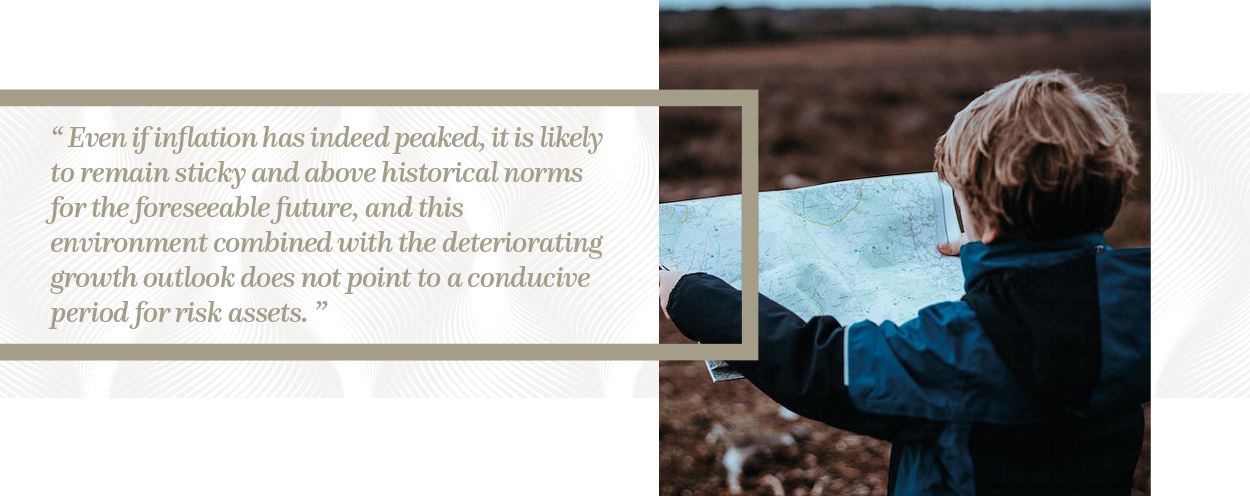Monthly Investment Outlook – December 2022
Market Overview
November saw a continuation of the equity market rally that started in mid-October, as markets expect a ‘Fed Pivot’, a sentiment triggered by a lower-than-expect US CPI reading last month. A falling crude price has also eased concerns over a global squeeze on household and corporate balance sheets, but with GDP growth set to further slow and with more rate hikes yet to come, we feel this rally may be short-lived. We suspect that the focus is now shifting from higher prices hurting sentiment to tighter policy weighing on activity – noting that monetary policy in major markets has tightened further at extraordinary speed in recent months.
The growing evidence for a global recession is indicated by manufacturing weakness led by softening demand, growing risks of a global house price collapse from record rises in rates and the increasingly clear reality that a China ‘reopening’ (that could drive growth) is not yet imminent. Even if inflation has indeed peaked, it is likely to remain sticky and above historical norms for the foreseeable future, and this environment combined with the deteriorating growth outlook does not point to a conducive period for risk assets.
The yield curves for the US, Europe and the UK remain very flat (and fully inverted over the 2 and 10yr rates) while the resurgence of equities in the fourth quarter means that valuations for many markets no longer seem particularly attractive. With the probability of recession increasing but not yet ‘priced in’, we find ourselves revisiting the appeal of investment grade bonds that now offer yield at the highest levels since 2011. As US interest rates approach their peak, new investment opportunities will start to rise though we believe there is likely to be further market weakness before we reach this point.
Equities |
Bonds |
Other |
|---|---|---|
| We are not convinced by the current rally, and feel valuations are not pricing in the increasingly poor economic backdrop. We favour quality and value stocks. | We retain an underweight to bonds while monetary policy is tightening, though will look to add to selective Investment Grade bonds now yields have improved | Liquid UCITS alternative funds are a crucial diversifier as traditional asset correlations have broken down. Gold and Silver look well set. |
Interest rate
Despite markets now expecting a nearer, lower peak in rates, the Fed is still set to hike a further 0.9% from current levels.
Central Bank Rates:
| Country | Current rate | 3 Months | 6 Months | 9 Months | Peak |
|---|---|---|---|---|---|
| US | 3.08 | 4.779 ↑ | 4.896 ↑ | 4.802 ↓ | 4.896 (May) |
| EU | 0.657 | 2.355 ↑ | 2.689 ↑ | 2.825 ↑ | 2.844 (September) |
| UK | 2.185 | 4.277 ↑ | 4.856 ↑ | 4.862 ↑ | 4.882 (August) |
| Japan | -0.055 | -0.006 ↑ | 0.044 ↑ | 0.063 ↑ | 0.124 (September) |
Our sub-asset class views
| – | = | + | ||||||
|---|---|---|---|---|---|---|---|---|
| EQUITIES | The fourth quarter of 2022 has offered some relief for equity markets, but we feel that valuations are not fully discounting the increasingly poor economic environment. | |||||||
| US | Equities are being directed by rate expectations at the moment, and while the US economy looks better placed than elsewhere, its’ growth bias makes it vulnerable. | |||||||
| UK | British stocks are still very cheap compared with other markets, and the energy/mining component of the 100 is attractive. Bleak political/economic backdrop. | |||||||
| Eurozone | Region is grappling with high inflation and energy prices while the ECB appears focused on this at the expense of the economy. Earnings estimates appear too optimistic. | |||||||
| Switzerland | Quality, defensive nature of the market continues to see Swiss stocks in demand, though valuations relatively rich now. | |||||||
| EM | We retain an allocation to emerging Asia for the long-term growth potential, though China remains a worry. Too early to consider other regions yet. | |||||||
| Japan | Attractive valuation for a developed market, with a lower yen supporting its export sector. Economy currently ‘reopening’ from Covid. | |||||||
| FIXED INCOME | The bond markets have stabilised after the early Autumn panic, and yields are more reasonably priced. Unclear whether a period of structurally higher rates and inflation is yet priced in. | |||||||
| Sovereign Bonds | US yield curve is inverted and rates remain under threat while inflation remains elevated. Recession may see some support, but not until FED expectations peak. | |||||||
| Corporate I.Grade Bonds | Buyers may soon come back with 5% yields for corporates looking attractive against a recessionary backdrop. US looks preferable to Europe. | |||||||
| High Yield Bonds | Default rates are subdued, but may rise as financing costs increase. Yields look attractive, but highly selective approach needed. | |||||||
| E.M. Bonds | We are generally cautious on emerging markets given looming recession fears, but our short duration approach achieves yield at acceptable risk. | |||||||
| ALTERNATIVES | An increasingly important allocation with equities expensive and bond yields so low. Ideally we like holdings that are genuinely uncorrelated to the main asset classes. | |||||||
| Precious Metals | Gold may get a boost as rate expectations peak. Remains the most compelling long-term hedge against inflation and elevated geopolitical risk. | |||||||
| Hedge Funds | Genuine alternative funds that behave in a different manner to traditional assets are a vital source of wealth preservation and diversification. | |||||||
| Oil/Commods | Commodities mania has subsided, but shifting geopolitics and green policies will offer structural upside over the longer term. |
| – | = | + | ||||||
|---|---|---|---|---|---|---|---|---|
| CURRENCIES | DXY strength has finally subsided with expectations of a Fed Pivot, though we think it is a premature to call the top until rate path is clear. GBP and EUR still represent ‘risk currencies’. | |||||||
| U.S. Dollar (DXY) | The dollar is only likely to retreat further if lower inflation trend is confirmed and FED becomes more dovish. Likely to be underpinned by relative resilience of US economy v Europe. | |||||||
| Sterling (GBP) | GBP has recovered more due to USD weakness than any great optimism over the UK’s economic prospects. Whether the BOE close the gap on the Fed will determine mid term outlook. | |||||||
| Euro (EUR) | Has rallied on USD weakness and following 0.75% ECB hike. Economy looks turgid, and ECB will be wary of hiking too hard in face of recession. | |||||||
| Japanese Yen (JPY) | JPY weakness has been the ccy story of the year, and looks overdone. Policy remains loose, but economy improving and BOJ have informally stepped in a 150 level. | |||||||
| Swiss Franc (CHF) | CHF remains relatively steady, as SNB underwhelmed with 0.75% hike. Swiss inflation much less than EUR and GBP. | |||||||
| EM | CNY has fallen dramatically due to new lockdowns, slowing economy and low rates. Elsewhere energy exporters are holding up in the face of USD strength. |


